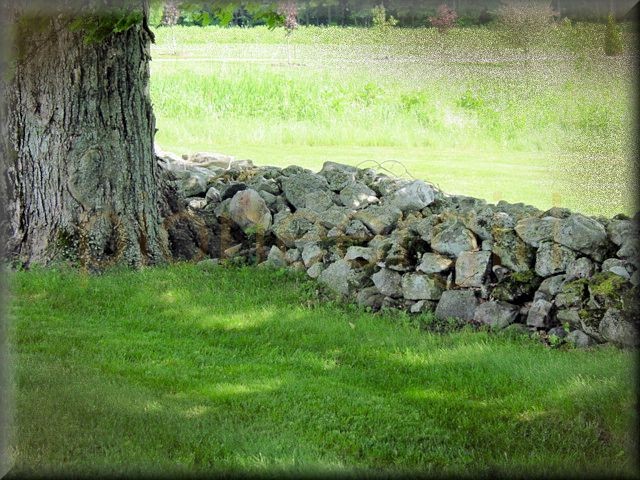stone fences

An enclosure about a field; especially, an enclosing structure of boulders or rocks, intended to prevent intrusion from without or straying from within. — Webster, 1882
 No sooner is a stone fence built than Nature acts to work to make it a part of herself. She adopts it and adorns it as if it were her own child. A little sprig of ivy may be seen creeping up the side and clinging fast with its many feet; a tuft of grass roots itself between two of the stones where a little dust from the road has been moistened into soil for it; a small bunch of fern grows in another such crevice; a deep, soft, green moss spreads itself over the top and along the sides of the fence; and wherever nothing else will grow lichens adhere to the stone and variegate their hues. Finally, a great deal of shrubbery is sure to cluster along its extent, and take away all hardness from the outline; and so the whole stone fence looks as if God had had at least as much to do with it as man. – Nathaniel Hawthorne
No sooner is a stone fence built than Nature acts to work to make it a part of herself. She adopts it and adorns it as if it were her own child. A little sprig of ivy may be seen creeping up the side and clinging fast with its many feet; a tuft of grass roots itself between two of the stones where a little dust from the road has been moistened into soil for it; a small bunch of fern grows in another such crevice; a deep, soft, green moss spreads itself over the top and along the sides of the fence; and wherever nothing else will grow lichens adhere to the stone and variegate their hues. Finally, a great deal of shrubbery is sure to cluster along its extent, and take away all hardness from the outline; and so the whole stone fence looks as if God had had at least as much to do with it as man. – Nathaniel Hawthorne
 Portions of the James Wilder property is still bordered by stone fences which may date from the time of Farmer Boy; they can be found on the northeast quarter and in places along the eastern property line. A bit of the fence can be seen from Stacy Road, shown in this photograph.
Portions of the James Wilder property is still bordered by stone fences which may date from the time of Farmer Boy; they can be found on the northeast quarter and in places along the eastern property line. A bit of the fence can be seen from Stacy Road, shown in this photograph.
Wherever there was plenty of loose stone which must be removed before the land could be cultivated, stone fences were the best and most economical that could be constructed. They were also one of the best ways to designate property boundaries.
The first thing in building a stone fence was to haul the stone. Usually this was done from year to year and hauled to a given place for the purpose of making a stone fence, although it was best not to leave stone within four or more feet from where the actual wall was to be built. Unless the earth was solidly and uniformly solid, it was best to dig a foundation deeper than the frost line. This would prevent movement in portions of the wall which might not cause it to fall, but would surely displace a few stones.
Size of a stone fence was usually determined by the size of the largest stone available. Stability was provided by having the wall wider at its base and tapering slightly to the top, which was best covered with the flattest stones possible. Most of the rock in the stone walls around the Wilder farm are around a foot in diameter (or smaller), and would have been easily lifted by a man. The Wilders’ stone fences were – by definition – more cobble-stone than boulder. Some are still standing that are about thirty inches wide at the base and a foot wide at the top, standing three or more feet in height. Although none are evident today, there were once said to be stone fences near the farmhouse itself. Although it’s not know how tall the Wilders’ stone fences were, a March 1878 notice posted in Burke, New York, specified that a stone fence was to be four feet high and that a board, log, rail or pole fence was to be five feet high.

stone fence (FB 1, 9, 11, 17, 22)

